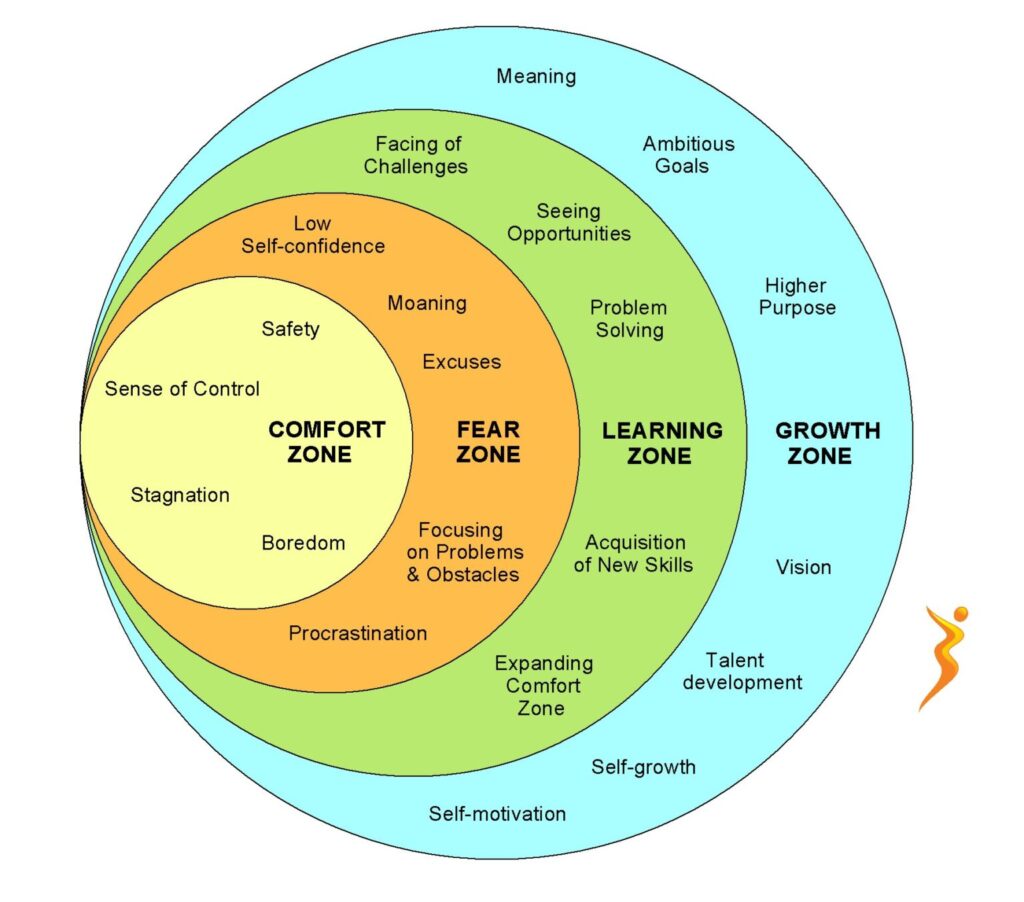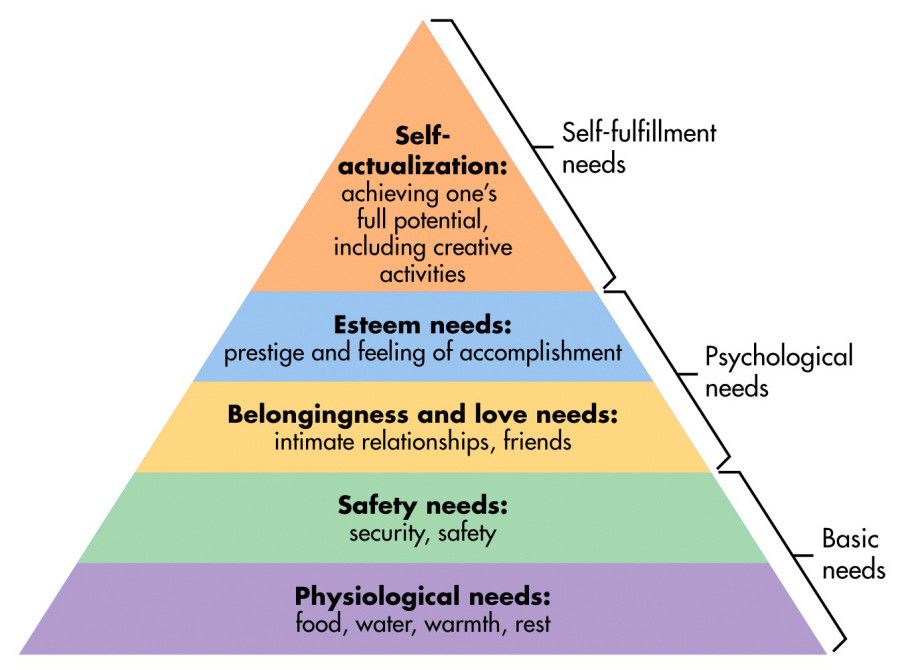How to leave your comfort zone and enter the ‘growth zone’
Life is full of opportunities, especially when you step outside your comfort zone, but this can be the challenging part.
What holds people back is mindset rather than a lack of knowledge or skill. The comfort zone is called the comfort zone for a reason, why would we actively try to make ourselves uncomfortable? It’s stressful and anxiety provoking.
This article explores the reasons why we should make ourselves uncomfortable, from the benefits in personal growth stepping out our comfort zone facilitates, to the best ways to ways to support leaving it.
What Is the Comfort Zone in Psychology?
The metaphor of ‘leaving one’s comfort zone’ became popular in the 1990s. The phrase ‘comfort zone’ was coined by management thinker Judith Bardwick in her 1991 work Danger in the Comfort Zone:
“The comfort zone is a behavioral state within which a person operates in an anxiety-neutral condition, using a limited set of behaviors to deliver a steady level of performance, usually without a sense of risk.”
Within the comfort zone, There isn’t much incentive for people to reach new heights of performance within the comfort zone. It’s here that people follow their routines, minimising risk and progress.
But the concept can be traced further back to a 1907 experiment by Robert Yerkes and John Dodson.
They discovered that mice were more motivated to complete a maze when given mild electrical shocks. However, the mice hid in fear rather than perform once the shocks became too strong. This was one of the first experiments that found a link between anxiety and performance.
According to the Yerkes-Dodson Law, an optimal level of pressure or anxiety increases performance (a fight response), but only up to a point. Too much pressure has the opposite effect, causing someone to panic (a flight or freeze response).

From Comfort Zone to the Growth Zone
When leaving the comfort zone, fear doesn’t always mean being in the panic zone. As shown in the diagram below, fear can be beneficial to getting you to the learning and growth zones:

It takes courage to step from the comfort zone into the fear zone. Often it’s new territory so you can’t build on new experiences, which can be anxiety provoking. However, showing up and working on whatever it is outside your comfort zone will lead you to the learning zone. This is where you gain new skills and deal with challenges resourcefully.
After a period of time spent in the learning zone, a new, larger comfort zone is formed, expanding one’s ability to reach even greater heights. This is what it means to be in the growth zone.
It’s helpful to have self-awareness as your start this journey. Know where your outer limit is and when your panic zone lies. Know what strengths you have that can be useful for you. Understand what you learned the last time you left your comfort zone.
Benefits of Leaving the Comfort Zone
1. Self-actualisation
For many, self-actualisation acts as a powerful incentive to leave the comfort zone. The concept was popularized through Abraham Maslow’s (1943) theory of human motivation, which he described as follows: “What a man can be, he must be. This need we may call self-actualization.”

Maslow’s hierarchy of needs operates from bottom to top, with the satisfaction of our ‘basic’ and ‘psychological’ needs being comparable to inhabiting the comfort zone.
The theory argues that the next need is personal growth and fulfilment. As long as the decision to leave the comfort zone aligns with personal values values, this shift is similar to making the move toward self-actualisation.
2. Development of a growth mindset
Stanford psychologist Carol Dweck’s (2008) research distinguished between two contrasting belief systems – the fixed versus growth mindsets.
With a fixed mindset, people believe they have set doses of each ability, with a corresponding ceiling on how much they can achieve. Failure reveals inadequacy, and criticism becomes a fatal blow to self-esteem.
The growth mindset means recognising humans as ever evolving. From this viewpoint, setbacks become opportunities for learning (Dweck, 1999) and our potential becomes unlimited.
Intentionally leaving the comfort zone demonstrates a growth mindset, while the fixed mindset keeps us trapped by fear of failure.
3. Resilience
Life is unpredictable. It’s filled with daily challenges, and some periods of time host more adversity than others. Cultivating the habit of expanding our comfort zones equips us to more readily deal with change and uncertainty, even when it rises unexpectedly, leading to resilience.
Eventually we learn to grow to new heights, bouncing back to an even better state than we started at.
4. Greater self-efficacy
As outlined by Albert Bandura (1997), self-efficacy is the belief in being able to execute necessary actions in service of a goal. Goals that lead to higher self-efficacy are specific, not too difficult, and short-term (Yailagh, Lloyd, & Walsh, 2009).
Leaving the comfort zone means a phase of trial and error, during which at least some level of success is inevitable. Experiencing this success builds our self-efficacy, with belief in our ability starting to grow.
Tips to Support Leaving Your Comfort Zone
1. Reframe stress
There’s no physiological difference between anxiety and excitement (Smith, Bradley, & Lang, 2005). Both lead to raised heartbeat, butterflies, and increased sweating. Whether this is perceived as positive or negative is a matter of how we choose to label it in that moment.
Framing this as positive stress as per Yerkes-Dodson Law can provide the energy to propel us through challenges outside of the comfort zone.
2. Understand neuroplasticity
Embracing neuroplasticity research can help you to internalise the idea that humans are malleable and adaptable. Once understood, less courage is needed to take the first step out the comfort zone because failure itself becomes valuable to the journey.
3. Prioritise
Staying in the comfort zone isn’t always detrimental. It may be harmless to stay in your piano-playing comfort zone but not your dead end job one.
Identify the areas of your life where staying in your comfort zone is doing more harm than good, for any reason such as emotionally because you’re not working toward your most ambitious goals.
4. Small steps
Small, methodical steps are just as valid as larger, bolder ones. Leaving behind the comfort zone doesn’t mean constant big risks or radical moves. Every step forward is progress.
5. Set personal goals
Set S.M.A.R.T. personal goals that will help you expand your comfort zone.
Get clear on your specific goals, write them down, and identify how each goal will benefit you. Setting goals gives you a sense of direction and helps you create a personal vision of what your life can look like.
6. Find your sweet spot
Like the mice in the Yerkes-Dodson experiment, decipher your optimal risk tolerance. If your risk tolerance is very low, start with small steps outside your comfort zone.
Finding the sweet spot of challenging yourself without pushing too far can make all the difference. Taking gradual baby steps will build up your risk tolerance and confidence.
7. Keep a positive mental attitude
Approach every situation and challenge with optimism. When you’re faced with uncertainty, try:
- Finding silver linings, see challenges as opportunities
- Having compassion for yourself when you fail
- Learning from each failure
- Challenging negative beliefs
6. Hang out with like-minded people
Identify the people in your life with a growth mindset that regularly take risks and are continuously learning, embracing challenges, and moving forward in spite of failure. Spend time with them, ask for their advice, understand their way of thinking, and emulate the qualities you admire in them.
Having a support system and people to learn from makes stepping outside your comfort zone a lot easier than doing it on your own.




